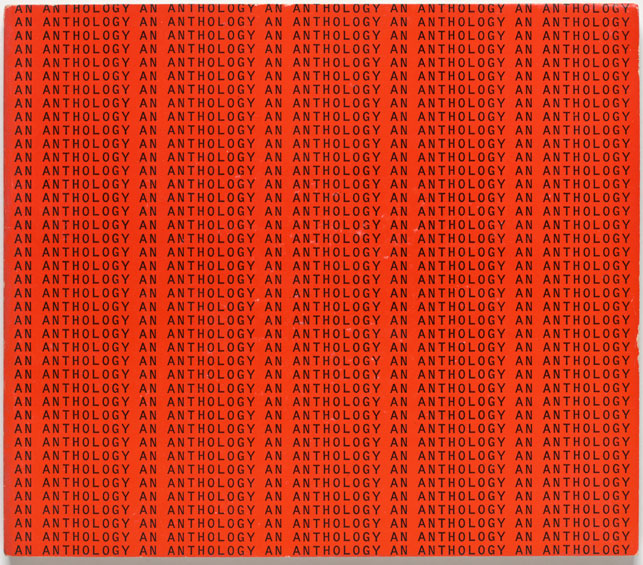La Monte Young, Jackson Mac Law (eds.): An Anthology of Chance Operations (1963)
Filed under artist publishing | Tags: · art, avant-garde, conceptual art, fluxus, music, poetry

A source-book of early Fluxus classics. A collection of scores, poetry, dance constructions, and other avant-garde work. Includes Henry Flynt’s first essay on concept art.
When the poet Chester Anderson, publisher of Beatitude, exited New York for California in 1959, he asked La Monte Young to edit Beatitude East, composed from the performance scores Young had collected in Berkeley and New York. In this he was aided by Jackson Mac Low, who had attended Cage’s composition course at the New School for Social Research and worked at the Living Theater with Julian Beck and Judith Malina.
Mac Low and Young provided Maciunas with connections to “beat” ideology, encouraging him not only to present radical programming at AG Gallery, but to design An Anthology, and to organize the initial 1962 Fluxus Festival in Wiesbaden, Germany. All of this was contemporaneous.
Maciunas supplied the paper, design and some money for the publishing of An Anthology, according to Henry Flynt, and had it ready for printing by October 1961. It was finally published by Young and Mac Low in 1963 as:
AN ANTHOLOGY of chance operations concept art anti-art indeterminacy improvisation meaningless work natural disasters plans of action stories diagrams Music poetry essays dance constructions mathematics compositions, BY GEORGE BRECHT, CLAUS BREMER, EARLE BROWN, JOSEPH BYRD, JOHN CAGE, DAVID DEGENER, WALTER DE MARIA, HENRY FLYNT, YOKO ONO, DICK HIGGINS, TOSHI ICHIYANAGI, TERRY JENNINGS, DENNIS, DING DONG, RAY JOHNSON, JACKSON MAC LOW, RICHARD MAXFIELD, ROBERT MORRIS, SIMONE MORRIS, NAM JUNE PAIK, TERRY RILEY, DITER ROT, JAMES WARING, EMMETT WILLIAMS, CHRISTIAN WOLFF, LA MONTE YOUNG/LA MONTE YOUNG – EDITOR/GEORGE MACIUNAS – DESIGNER.
The first edition (it was reprinted in 1972 by Hundermark, Germany) contains 67 leaves and three inserts. It includes multicolored and onionskin paper, card stock and two envelopes. The text was printed in offset with a heavy paper cover, collated manually with a staple and perfect binding.
Self-published, New York, Spring 1963
Layout by George Maciunas
120 pages
PDF (36 MB, updated on 2012-7-9)
Comment (1)Roy Ascott (ed.): Art, Technologies, Consciousness: mind@large (2000)
Filed under book | Tags: · architecture, art, artificial life, computer music, consciousness, interactivity, metaphysics, music, perception, performance, quantum mechanics, robotics, semiotics, synaesthesia, technoetics, technology, telematics

Within a technological context, this volume addresses contemporary theories of consciousness, subjective experience, the creation of meaning and emotion, and relationships between cognition and location. Its focus is both on and beyond the digital culture, seeking to assimilate new ideas emanating from the physical sciences as well as embracing spiritual and artistic aspects of human experience.
Developing on the studies published in Roy Ascott’s successful Reframing Consciousness, the book documents the very latest work from those connected with the internationally acclaimed CAiiA-STAR centre and its conferences. Their artistic and theoretical research in new media and art includes aspects of:
• artificial life
• robotics
• technoetics
• performance
• computer music
• intelligent architecture
• telematic art
With profound insights for those in fields of Art, Media and Design – both academics and professionals — this book will also provide new ideas for software designers working on material to be used by the arts community.
Publisher Intellect Books, 2000
ISBN 1841500410, 9781841500416
204 pages
PDF (updated on 2012-7-24)
Comment (1)Timothy Morton: Ecology Without Nature: Rethinking Environmental Aesthetics (2007)
Filed under book | Tags: · aesthetics, animal, art, capitalism, ecocriticism, ecology, environment, kitsch, music, nature, object, phenomenology, philosophy, rhetoric, romanticism, sound

“In Ecology without Nature, Timothy Morton argues that the chief stumbling block to environmental thinking is the image of nature itself. Ecological writers propose a new worldview, but their very zeal to preserve the natural world leads them away from the “nature” they revere. The problem is a symptom of the ecological catastrophe in which we are living. Morton sets out a seeming paradox: to have a properly ecological view, we must relinquish the idea of nature once and for all.
Ranging widely in eighteenth-century through contemporary philosophy, culture, and history, Morton explores the value of art in imagining environmental projects for the future. Morton develops a vocabulary for reading “environmentality” in artistic form as well as content, and traces the contexts of ecological constructs through the history of capitalism. From John Clare to John Cage, from Kierkegaard to Kristeva, from The Lord of the Rings to electronic life forms, Ecology without Nature extends the view of ecological criticism. Instead of trying to use an idea of nature to heal what society has damaged, Morton sets out a new form of ecological criticism: “dark ecology.””
Publisher Harvard University Press, 2007
ISBN 0674024346, 9780674024342
249 pages
Reviews: Keegan (Studies in Romanticism, 2008), Philips (Oxford Literary Review, 2010), Holmes (Journal of Ecocriticism, 2012).
PDF (updated on 2012-10-31)
Comment (0)
